1996 CHEVROLET TAHOE parking brake
[x] Cancel search: parking brakePage 212 of 403
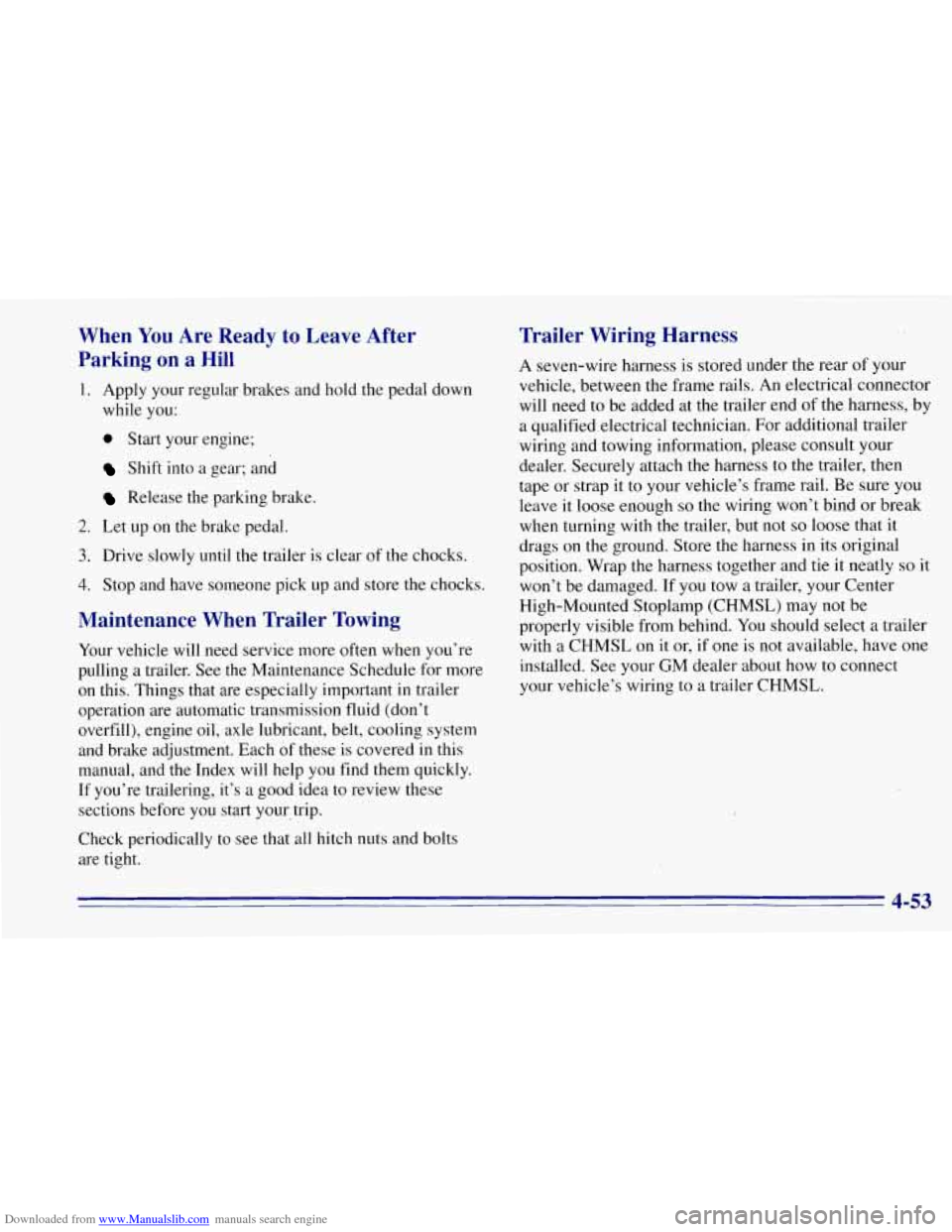
Downloaded from www.Manualslib.com manuals search engine When You Are Ready to Leave After
Parking on a Hill
1. Apply your regular brakes and hold the pedal down
while you:
0 Start your engine;
Shift into a gear; and
Release the parking brake.
2. Let ,up on the brake pedal.
3. Drive slowly until the trailer is clear of the chocks.
4. Stop and have someone pick up and store the chocks.
Maintenance When Trailer Towing
Your vehicle will need service more often when you’re
pulling a trailer. See the Maintenance Schedule for more
on this. Things that are especially important in trailer
operation are automatic transmission fluid (don’t overfill), engine oil, axle lubricant, belt, cooling system
and brake adjustment. Each
of these is covered in this
manual, and the Index will help you find them qoickly.
If you’re trailering, it’s a good idea to review these
sections before you start your trip.
Check periodically to see that all hitch nuts and bolts
are tight.
Trailer Wiring Harness
A seven-wire harness is stored under the rear of your
vehicle, between the frame rails. An electrical connector
will need to be added at the trailer end
of the harness, by
a qualified electrical technician. For additional trailer
wiring and towing information, please consult your
dealer. Securely attach the harness to the trailer, then
tape or strap it to your vehicle’s frame rail. Be
sure you
leave it loose enough so the wiring won’t bind or break
when turning with the trailer, but not
so loose that it
drags on the ground. Store’ the harness in its original
position. Wrap the harness together and tie it neatly
so it
won’t be damaged.
If you tow a trailer, your Center
High-Mounted Stoplamp (CHMSL) may not be
properly visible from behind.
You should select a trailer
with a CHMSL on
it or, if one is not available, have one
installed. See your GM dealer about how to connect
your vehicle’s wiring to a trailer CHMSL.
4-53
Page 213 of 403
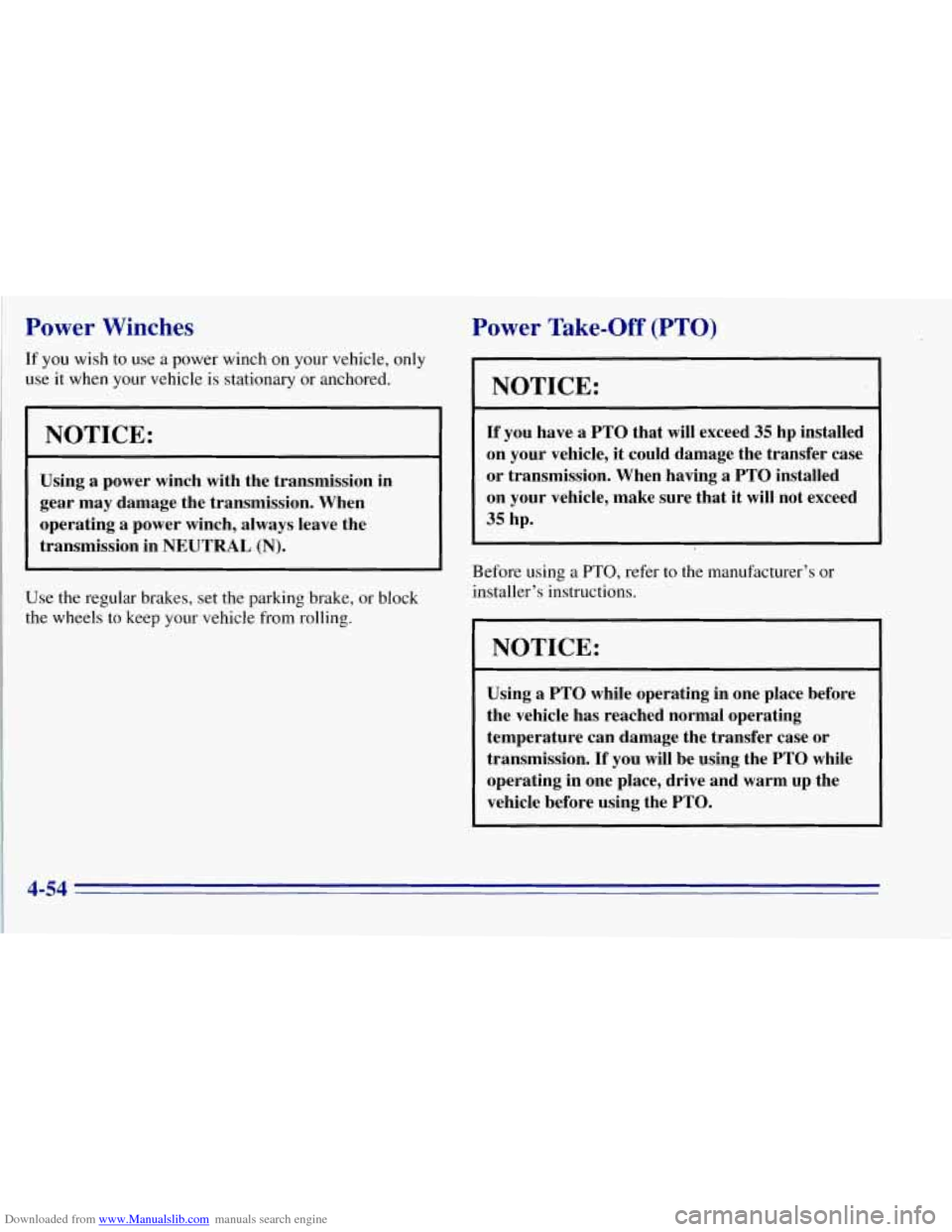
Downloaded from www.Manualslib.com manuals search engine Power Winches Power Take-Off (PTO)
If you wish to use a power winch on your vehicle, only
use it when your vehicle is stationary or anchored.
NOTICE:
Using a power winch with the transmission in
gear may damage the transmission. When
operating
a power winch, always leave the
transmission in NEUTRAL
(N).
Use the regular brakes, set the parking brake, or block
the wheels to keep your vehicle from rolling.
NOTICE:
If’ you have a PTO that will exceed 35 hp installed
on your vehicle,
it could damage the transfer case
or transmission. When having
a PTO installed
on your vehicle, make sure that
it will not exceed
35 hp.
Before using a PTO, refer to the manufacturer’s or
installer’s instructions.
NOTICE:
Using a PTO while operating in one place before
the vehicle has reached normal operating
temperature can damage the transfer case or
transmission. If you will be using the PTO while
operating in one place, drive and warm up the
vehicle before using the PTO.
4-54
Page 214 of 403

Downloaded from www.Manualslib.com manuals search engine To engage a PTO:
1. Set the parking brake.
2. Shift the transmission into NEUTRAL (N).
3. Hold the clutch pedal down and engage the PTO.
NOTICE:
Using a PTO for more than four hours without
driving your vehicle can damage the transfer case
or transmission. If using a PTO for more than
four hours without driving your vehicle, drive
your vehicle for a while
to allow the transfer case
and transmission to
cool.
If you are going to drive the vehicle, shift the
transmission into the,gear
you want. Then shift the
transfer case into the range
you want (if you have
four-wheel drive), apply the regular brakes and
release the parking brake.
4. Release the clutch (and the regular brakes) as you
normally would. When you release the clutch, the
PTO will start.
Using a Transfer Case Mounted PTO
1. Set the parking brake.
2. Shift the transfer case into NEUTRAL (N).
3. Shift the transmission into NEUTRAL (N).
4. Engage the PTO.
If you are going to drive the vehicle, shift the
transfer case into the range
you want. Then apply the
regular brakes and release the parking brake.
5. Shift the transmission to THIRD (3) to start the PTO.
6. Release the regular brakes to drive the vehicle.
4-55
Page 217 of 403
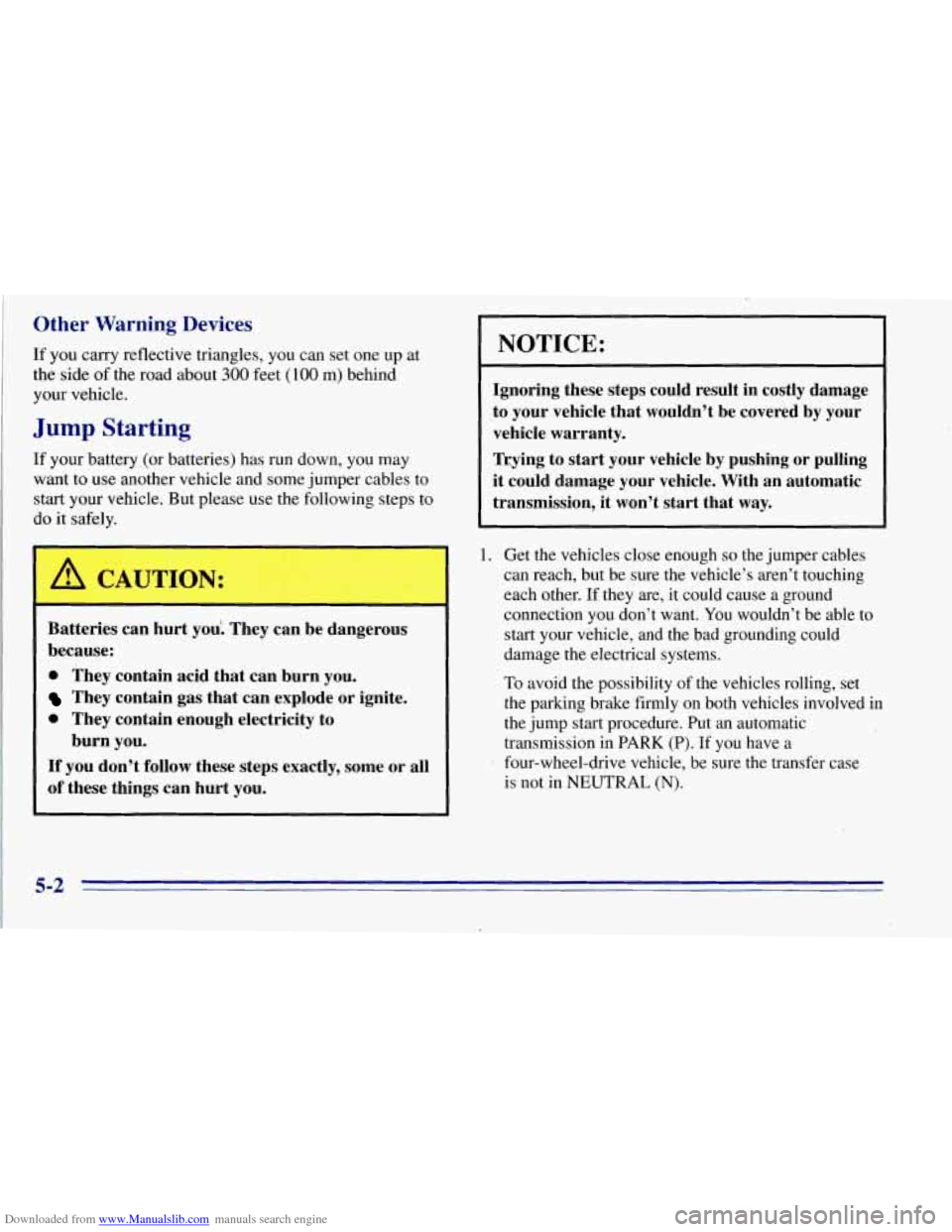
Downloaded from www.Manualslib.com manuals search engine Other Warning Devices
If you carry reflective triangles, you can set one up at .
the side of the road about 300 feet (100 m) behind
your vehicle.
Jump Starting
If your battery ,(or batteries) has run down, you may
want
to use another vehicle and some jumper cables to
start your vehicle. But please use the following steps to
do it safqly.
A CAUTION:
Batteries can hurt you! They can be dangerous
because:
0 They contain acid that can burn you.
They contain gas that can explode or ignite.
0 They contain enough electricity to
If you don’t follow these steps exactly, some or all
of these things can hurt you.
burn
you.
NOTICE:
Ignoring these steps could result in costly damage
to your vehicle that wouldn’t be covered by your
vehicle warranty.
Trying to start your vehicle by pushing or pulling
it could damage your vehicle. With an automatic
transmission,
it won’t start that way.
1. Get the vehicles close enough so the jumper cables
can reach, but be sure the vehicle’s aren’t touching
each other. If they are, it could cause a ground
connection you don’t want. You wouldn’t be able to
start your vehicle, and the bad grounding could
damage the electrical systems.
To avoid the possibility
of the vehicles rolling, set
the parking brake firmly on both vehicles involved in
the jump start procedure. Put an automatic
transmission in
PARK (P). If you have a
four-wheel-drive vehicle, be sure the transfer case
is not in NEUTRAL (N).
5-2
Page 222 of 403
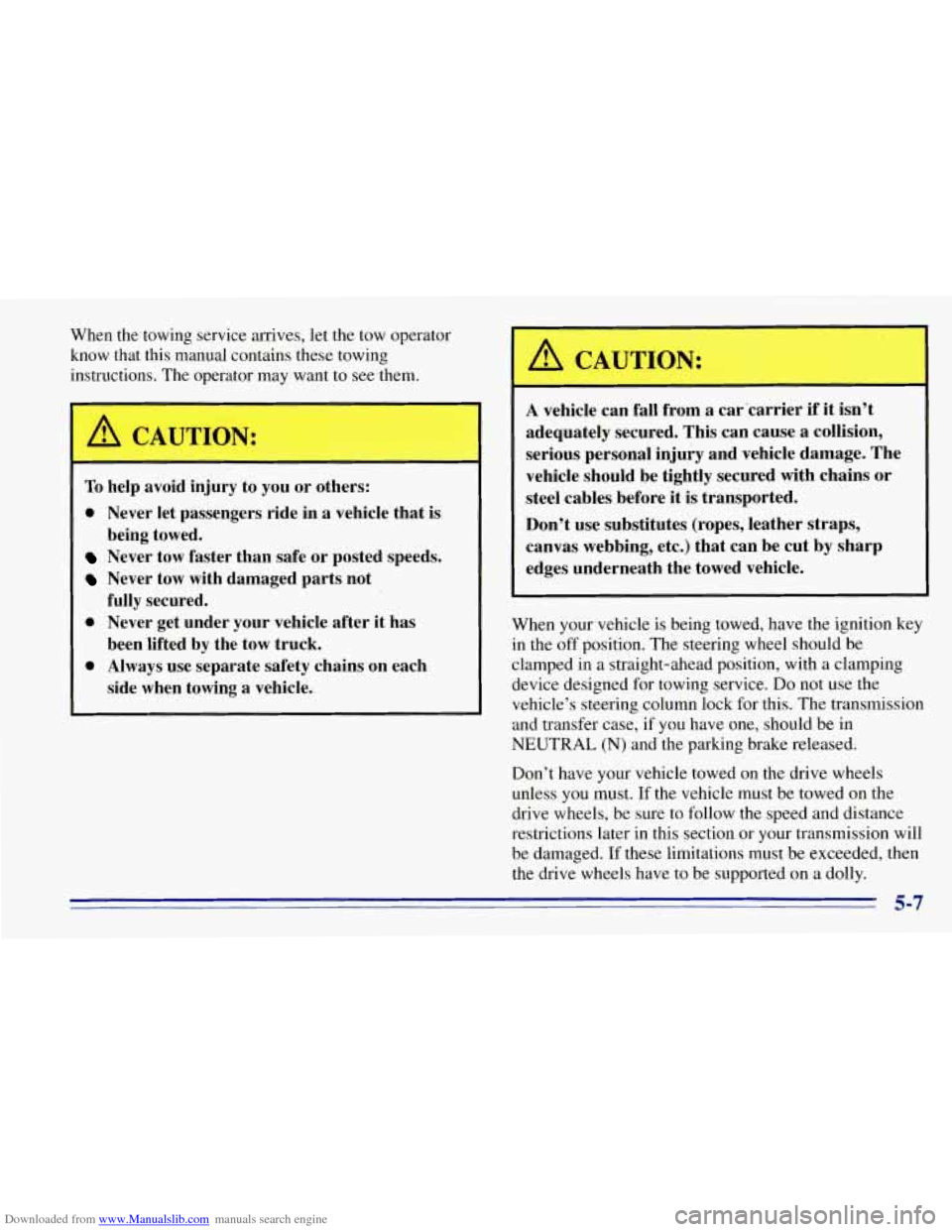
Downloaded from www.Manualslib.com manuals search engine When the towing service arrives, let the tow operator
know that this manual contains these towing
instructions. The operator may want to
see them.
I
A CAUTIO! :
To help avoid injury to you or others:
0 Never let passengers ride in a vehicle that is
Never tow faster than safe or posted speeds.
Never tow with damaged parts not
0 Never get under your vehicle after it has
0 Always use separate safety chains on each
being towed.
fully secured.
been lifted
by the tow truck.
side when towing
a vehicle.
- I
A vehicle can fall from a car’carrier if it isn’t
adequately secured. This can cause
a collision,
serious personal injury and vehicle damage. The
vehicle should be tightly secured with chains or
steel cables before it is transported.
Don’t use substitutes (ropes, leather straps,
canvas webbing, etc.) that can be cut
by sharp
edges underneath the towed vehicle.
When your vehicle is being towed, have the ignition key
in the off position. The steering wheel should be
clamped in a straight-ahead position, with
a clamping
device designed for towing service.
Do not use the
vehicle’s steering column lock for this. The transmission
and transfer case, if
you have one, should be in
NEUTRAL (N) and the parking brake released.
Don’t have your vehicle towed on the drive wheels
unless you must. If the vehicle must be towed
on the
drive wheels, be sure to follow the speed and distance
restrictions later in this section or your transmission will
be damaged. If these limitations must be exceeded, then
the drive wheels have
to be supported on a dolly.
5-7
Page 235 of 403
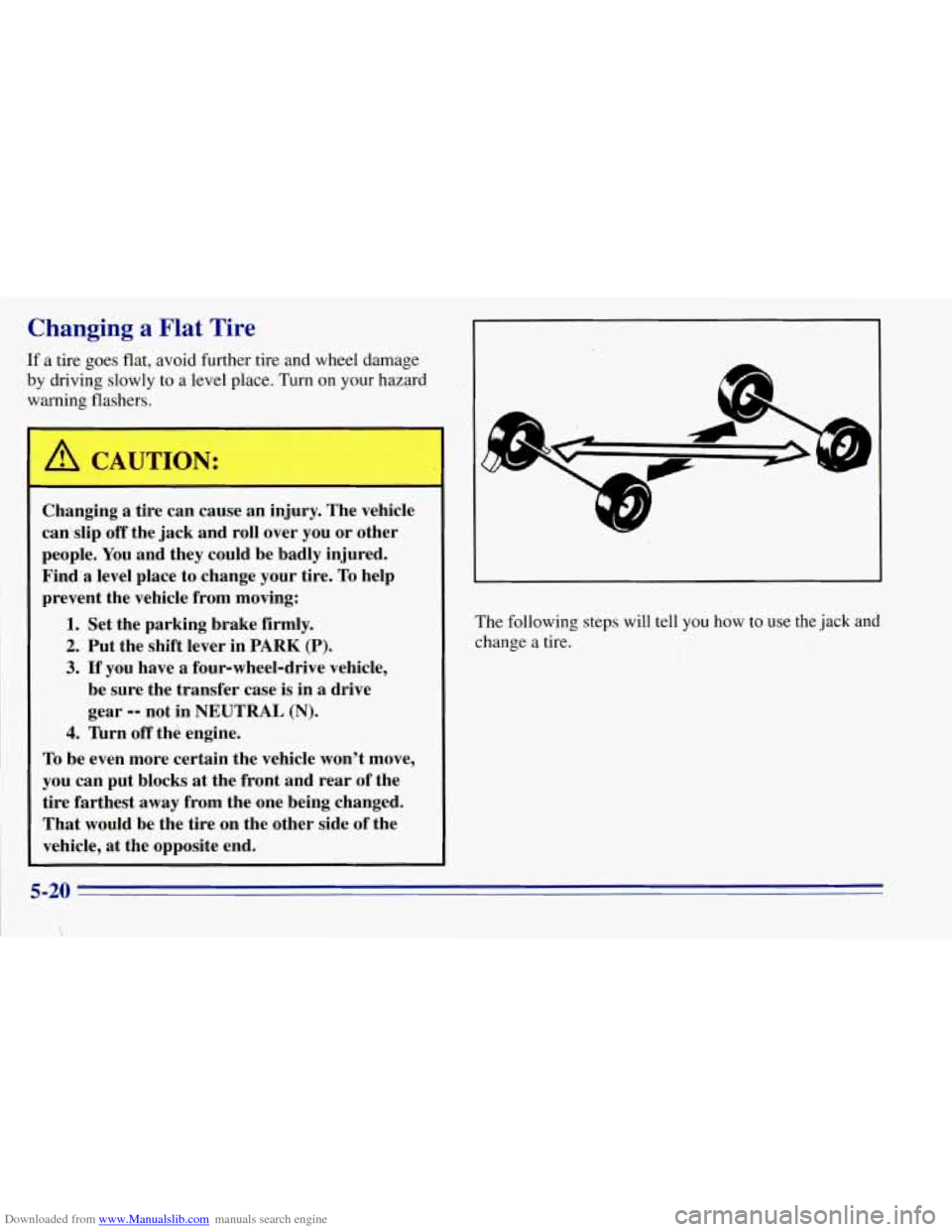
Downloaded from www.Manualslib.com manuals search engine Changing a Flat Tire
If a tire goes flat, avoid further tire and wheel damage
by driving slowly to a level place. Turn on your hazard
warning flashers.
I
Changing a tire can cause an injury. The vehicle
can,slip off the jack and roll over you or other
people. You and they could be badly injured.
Find a level place to change your tire. To help
prevent the vehicle from moving:
1. Set the parking brake firmly.
2. Put the shift lever in PARK (P).
3. If you have a four-wheel-drive vehicle,
be sure the transfer case is in a drive
gear
-- not in NEUTRAL (N).
4. Wrn off the engine.
To be even more certain the vehicle won’t move,
you can put blocks at the front and rear of the
tire farthest away from the one being changed.
That would be the tire on the other side of the
vehicle, at the opposite end.
i,
The following steps will tell you how to use the jack and
change a tire.
Page 273 of 403
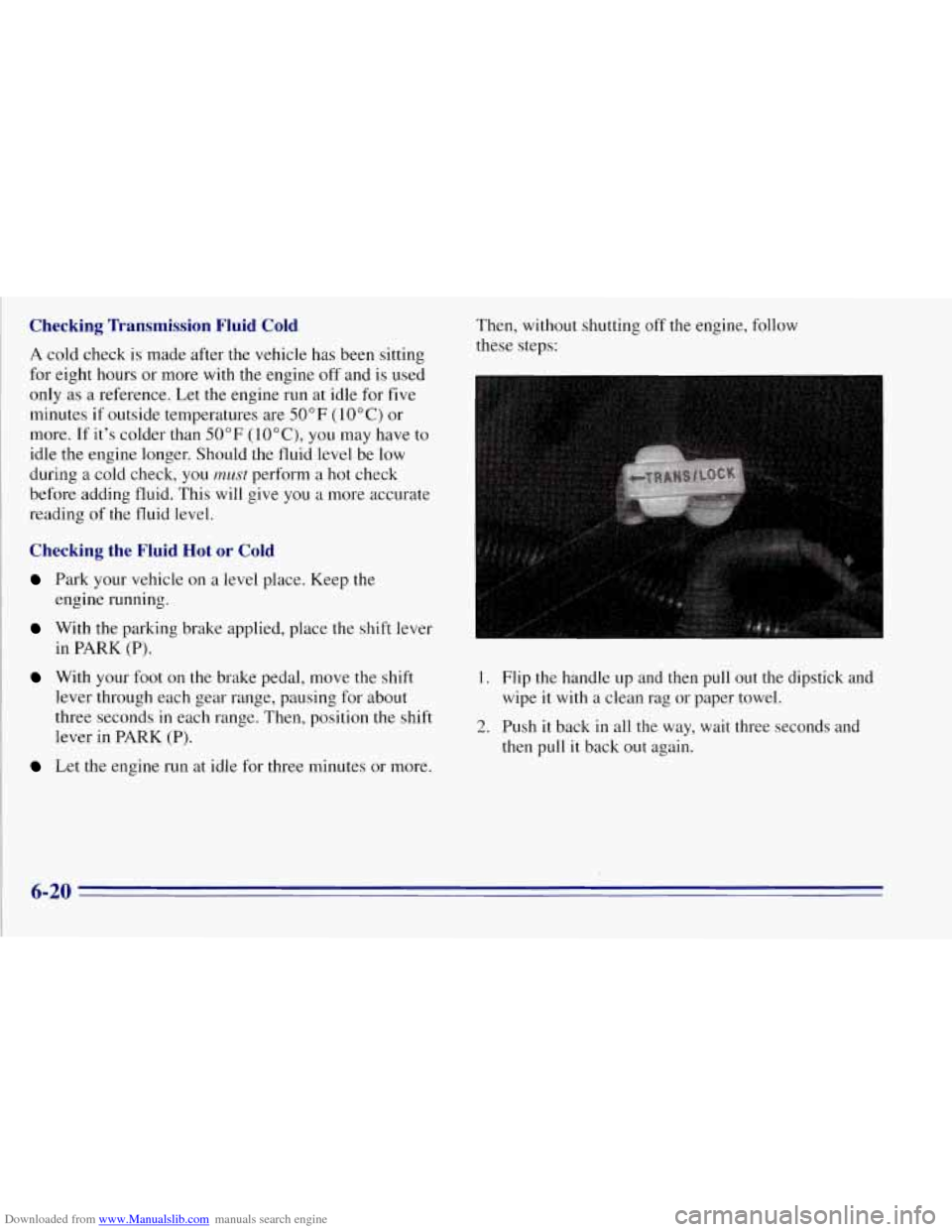
Downloaded from www.Manualslib.com manuals search engine Checking Transmission Fluid Cold
A cold check is made after the vehicle has been sitting
for eight hours or more with the engine off and is used
only
as a reference. Let the engine run at idle for five
minutes if outside temperatures are
50°F ( 10°C) or
more.
If it's colder than 50°F ( lO"C), you may have to
idle the engine longer. Should the fluid level be low
during a cold check, you
must perform a hot check
before adding fluid. This will give you
a more accurate
reading
of the fluid level.
Checking the Fluid Hot or Cold
Park your vehicle on a level place. Keep the
engine running.
With the parking brake applied, place the shift lever
in PARK (P).
With your foot on the brake pedal, move the shift
lever through each gear range, pausing for about
three seconds
in each range. Then, position the shift
lever
in PARK (P).
Let the engine run at idle for three minutes or more. Then,
without shutting off the engine, follow
Lhese steps:
1. Flip the handle up and then pull out the dipstick and
wipe it with
a clean rag or paper towel.
2. Push it back in all the way, wait three seconds and
then pull it back out again.
6-20
Page 333 of 403
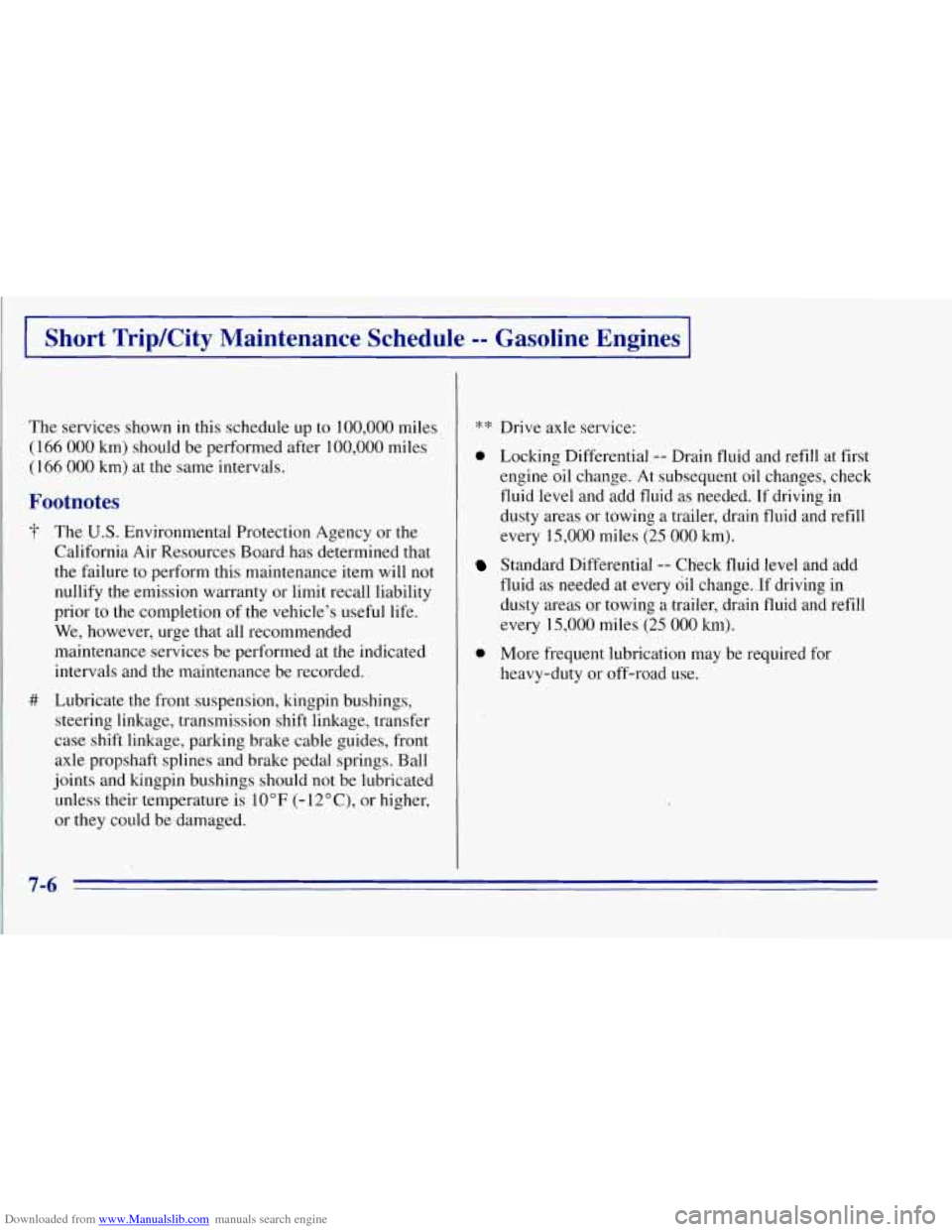
Downloaded from www.Manualslib.com manuals search engine I Short Trip/City Maintenance Schedule -- Gasoline Engines
The services shown in this schedule up to 100,000 miles
( 166 000 km) should be performed after 100,000 miles
(166 000 km) at the same intervals.
Footnotes
The U.S. Environmental Protection Agency or the
California Air Resources Board has determined that
the failure to perform this maintenance item will
not
nullify the emission warranty or limit recall liability
prior to the completion
of the vehicle's useful life.
We, however, urge that all recommended
maintenance services
be performed at the indicated
intervals and the maintenance be recorded.
# Lubricate the front suspension, kingpin bushings,
steering linkage, transmission shift linkage, transfer
case shift linkage, parking brake cable guides, front
axle propshaft splines and brake pedal springs. Ball
joints and kingpin bushings should not be lubricated
unless their temperature
is 10°F (-12"C), or higher,
or they could be damaged.
** Drive axle service:
0 Locking Differential -- Drain fluid and refill at first
engine oil change. At subsequent oil changes, check
fluid level and add fluid as needed. If driving in
dusty areas or towing a trailer, drain fluid and refill
every
15,000 miles (25 000 km).
Standard Differential -- Clieck fluid level and add
fluid as needed at every oil change. If driving in
dusty areas or towing a trailer, drain fluid and refill
every
15,000 miles (25 000 km).
0 More frequent lubrication may be required for
heavy-duty or off-road use.
7-6